Decoding Harmonics: Total Harmonic Distortion in Solar Photovoltaic Systems with Integrated Battery Storage
Abstract
1. Introduction
- Analyze the power quality in a 400 kWp grid-connected solar photovoltaic system with storage (BESS), considering standards IEEE Std 519TM, IEEE Std 1159TM, and IEC 61000-4-30 in the analysis, using Neplan-Smarter Tools software for model validation.
- Contribute a methodology and procedure for measurement and power quality assessment, allowing for THD identification.
- Enable designers to configure better designs and energy system protections when integrating solar photovoltaic energy into an electrical distribution network.
2. Mathematical Model
2.1. Total Energy Generated by the PV System
2.2. Total Harmonic Distorsion (THD)
3. Monitored System and Measurements: Demand and Generation
- Substation No. 1—500 kVA transformer (13.200/480/277 V). Main load: Central administrative building.
- Substation No. 2—1000 kVA transformer (13.200/480/277 V). The electrical loads are four classroom buildings, a university welfare building, a water plant, and a fitness student center.
- Substation No. 3—800 kVA dry transformer (13.200/480/277 V). Loads: central building cooling plant.
- Phase 1: 150 kWp. Composed of 298 Panasonic 240 Wp (VBHN240) and 345 Panasonic modules (model-23030)—Tier 1. A topology of a 50 kWp subsystem with 10 and 11 parallel series strings is presented in Figure 3. The solar modules’ features are listed in Table 3, and the inverter data are listed in Table 4.
- Phase 2: 250 kWp. Composed of a 944 module with 265 Wp (HR—265) Hareon Solar—Tier 2.
3.1. Power and Parameter Measurements
3.2. Methodology
3.2.1. Model Setup in NEPLAN
Technical Parameters of Power Energy Systems
4. Results: Current and Voltage Measurements
4.1. Monthly Generated Energy
4.2. Simulation and Results
4.3. Simulation of the Grid-Tie System Using BESS
5. Discussion
6. Conclusions
- Analysis Focus: This analysis focused on power quality in a 400 kWp grid-connected solar photovoltaic system with battery storage (BESS).
- Standards Considered: This analysis considered IEEE Std 519TM, IEEE Std 1159TM, and IEC 61000-4-30.
- Key Findings: The key findings include high total harmonic distortion in current (THDi) under low power conditions. In addition, voltage distortion (THDv) remained below 2.5%.
- Global Expansion: Solar PV systems are rapidly expanding as a feasible alternative for energy production.
- Harmonic Generation: These systems can affect power grid quality, generating low and high current harmonics due to the DC-to-AC conversion process in inverters.
- Model Development: A photovoltaic array model was developed and validated using Neplan-Smarter Tools software.
- Experimental Measurements: Experimental measurements were performed on the actual grid-connected 430 kWp solar PV system, recording electrical variables like current, voltage, power, power factor, and THD, using a class B power quality monitor for accurate measurements.
- High THDi Levels: High THDi levels were recorded under a real scenario with low-energy-demand conditions, especially when generated energy was below 20% of rated power.
- THDv Compliance: THDv compliance remained within acceptable limits as per IEEE 519 standards.
- BESS Impact: The simulation showed that the connection of BESS helped regulate voltage levels.
- Power Quality Maintenance: Solar PV systems with integrated BESS can maintain power quality within acceptable limits.
- THDi Concerns: High THDi levels are a concern under low power conditions, necessitating further research and optimization.
Author Contributions
Funding
Data Availability Statement
Acknowledgments
Conflicts of Interest
References
- Hara, R.; Kita, H.; Tanabe, T.; Sugihara, H.; Kuwayama, A.; Miwa, S. Demonstration grid-connected photovoltaic projects in Japan. Proc. IEEE Power Energy Mag. 2009, 7, 77–85. [Google Scholar] [CrossRef]
- Almaktar, M.; Shaaban, M. Prospects of renewable energy as a non-rivalry energy alternative in Libya. Renew. Sustain. Energy Rev. 2021, 143, 110852. [Google Scholar] [CrossRef]
- Liu, E.; Bebic, J. Distribution System Voltage Performance Analysis for High Penetration Photovoltaics; National Renewable Energy Laboratory (NREL): Golden, CO, USA, 2008. [Google Scholar]
- Fekete, K.; Klaic, Z.; Majdandzic, L. Expansion of the residential photovoltaic systems and its harmonic impact on the distribution grid. Renew. Energy 2012, 43, 140–148. [Google Scholar] [CrossRef]
- Ackermann, T. Distributed resources and re-regulated electricity markets. Electr. Power Syst. Res. 2007, 77, 1148–1159. [Google Scholar] [CrossRef]
- Ahsan, S.M.; Khan, H.A.; Hussain, A.; Tariq, S.; Zaffar, N.A. Harmonic Analysis of Grid-Connected Solar PV Systems with Nonlinear Household Loads in Low-Voltage Distribution Networks. Sustainability 2021, 13, 3709. [Google Scholar] [CrossRef]
- Khalid, M.R.; Alam, M.S.; Sarwar, A.; Asghar, M.J. A Comprehensive review on electric vehicles charging infrastructures and their impacts on power-quality of the utility grid. eTransportation 2019, 1, 100006. [Google Scholar] [CrossRef]
- Elkholy, A. Harmonics assessment and mathematical modeling of power quality parameters for low voltage grid connected photovoltaic systems. Sol. Energy 2019, 183, 315–326. [Google Scholar] [CrossRef]
- Elphick, S.T. The Modern Domestic Load and Its Impact on the Electricity Distribution Network; University of Wollongong: Wollongong, Australia, 2011; Available online: http://ro.uow.edu.au/theses/3502 (accessed on 1 August 2023).
- Durán, J.C.; Raggio, D.; Socolovsky, H.P.; Videla, M.; Plá, J. Evaluación De La Calidad De La Energía En Dos Casos De Estudio: Distorsión Armónica Inyectada Por Un Sistema Fotovoltaico De 40 Kw Y Emitida Por Las Cargas De Una Vivienda Unifamiliar. Av. Energías Renov. Medio Ambiente 2016, 20, 13–14. [Google Scholar]
- IEEE Std 1100-1999; IEEE Recommended Practice for Powering and Grounding Electronic Equipment. IEEE: New York, NY, USA, 1999. [CrossRef]
- Torquato, R.; Trindade, F.; Freitas, W. Analysis of the harmonic distortion impact of photovoltaic generation in Brazilian residential networks. In Proceedings of the 2014 16th International Conference on Harmonics and Quality of Power (ICHQP), Bucharest, Romania, 25–28 May 2014; pp. 239–243. [Google Scholar]
- Chicco, G.; Mancarella, P. Distributed multi-generation: A comprehensive view. Renew. Sustain. Energy Rev. 2009, 13, 535–551. [Google Scholar] [CrossRef]
- Ulianov, Y.; Orozco, M.A. Power Quality Performance of a Grid-Tie Photovoltaic System in Colombia. In Proceedings of the IEEE Transmission and Distribution Latin-America Conference and Exposition, Montevideo, Uruguay, 3–5 September 2012. [Google Scholar]
- Karadeniz, A.; Ozturk, O.; Koksoy, A.; Atsever, M.B.; Balci, M.E.; Hocaoglu, M.H. Accuracy assessment of frequency-domain models for harmonic analysis of residential type photovoltaic-distributed generation units. Sol. Energy 2022, 233, 182–195. [Google Scholar] [CrossRef]
- González Pacheco, C. Simulación De Un Inversor Trifásico Conectado A Red Desde Paneles Fotovoltaicos Y Diseño De Su Control; Universidad Politécnica de Madrid: Madrid, Spain, 2018. [Google Scholar]
- Eltawil, M.A.; Zhao, Z. Grid-connected photovoltaic power systems: Technical and potential problems—A review. Renew. Sustain. Energy Rev. 2010, 14, 112–129. [Google Scholar] [CrossRef]
- Elomari, Y.; Norouzi, M.; Marín-Genescà, M.; Fernández, A.; Boer, D. Integration of Solar Photovoltaic Systems into Power Networks: A Scientific Evolution Analysis. Sustainability 2022, 14, 9249. [Google Scholar] [CrossRef]
- Mahela, O.P.; Khan, B.; Alhelou, H.H.; Tanwar, S.; Padmanaban, S. Harmonic mitigation and power quality improvement in utility grid with solar energy penetration using distribution static compensator. IET Power Electron. 2021, 14, 912–922. [Google Scholar] [CrossRef]
- Sakar, S.; Balci, M.E.; Aleem, S.H.A.; Zobaa, A.F. Integration of large-scale PV plants in non-sinusoidal environments: Considerations on hosting capacity and harmonic distortion limits. Renew. Sustain. Energy Rev. 2018, 82, 176–186. [Google Scholar] [CrossRef]
- Panneerselvam, S.; Srinivasan, B. Switching loss analysis of IGBT and MOSFET in single phase PWM inverter fed from photovoltaic energy sources for smart cities. Int. J. Syst. Assur. Eng. Manag. 2022, 13 (Suppl. 1), 718–726. [Google Scholar] [CrossRef]
- Mahfuz-Ur-Rahman, A.M.; Islam, M.R.; Muttaqi, K.M.; Rahman, M.A.; Sutanto, D. An advanced modulation technique for transformerless grid connected inverter circuits used in solar photovoltaic systems. IEEE Trans. Ind. Electron. 2022, 70, 3878–3887. [Google Scholar] [CrossRef]
- Fuentes, C.D.; Müller, M.; Bernet, S.; Kouro, S. SiC-MOSFET or Si-IGBT: Comparison of design and key characteristics of a 690 V grid-tied industrial two-level voltage source converter. Energies 2021, 14, 3054. [Google Scholar] [CrossRef]
- Sen, S. Medium voltage extreme fast charger based on novel medium voltage SiC power devices. The University of Texas at Austin. Dissertation Presented to the Faculty of the Graduate School of The University of Texas at Austin in Partial Fulfillment of the Requirements for the Degree of Doctor of Philosophy, Austin, TX, USA. 2021. Available online: https://repositories.lib.utexas.edu/items/020d17a0-6acc-4537-acc1-6b016e0a4cec (accessed on 1 August 2023).
- Jalan, R.; Gaur, C.; Pandey, J.P. Analysis of Harmonic Reduction Using An Intelligent Control Active Filter in A Solar Grid with Variable Load. SSRG Int. J. Electr. Electron. Eng. 2024, 11, 212–222. [Google Scholar] [CrossRef]
- Morsli, A.; Tlemçani, A.; Krama, A.; Abbadi, A.; Zellouma, L.; Nouri, H. Applying the Direct Power Control Strategy in a Shunt Active Filter by Exploiting the Solar Photovoltaic Energy as a Continuous Source. Nonlinear Dyn. Syst. Theory 2020, 20, 410–424. [Google Scholar]
- Barva, A.; Joshi, S. Comparative Analysis of Passive, Active, and Hybrid Active Filters for Power Quality Improvement in Grid-Connected Photovoltaic System. In Proceedings of the 2023 7th International Conference on Computer Applications in Electrical Engineering-Recent Advances (CERA), Roorkee, India, 27–29 October 2023; pp. 1–6. [Google Scholar] [CrossRef]
- Benedicte, M.; Moses, P. Design of Hybrid Active Power Filters (HAPFs) for Grid-Connected Photovoltaic Systems Using Modified p-q theory. In Proceedings of the 2022 IEEE PES/IAS PowerAfrica, Kigali, Rwanda, 22–26 August 2022; pp. 1–5. [Google Scholar] [CrossRef]
- Boopathi, R.; Indragandhi, V. Enhancement of power quality in grid-connected systems using a predictive direct power controlled based PV-interfaced with multilevel inverter shunt active power filter. Sci. Rep. 2025, 15, 7967. [Google Scholar] [CrossRef]
- Da Silva, R.P.B.; Quadros, R.; Shaker, H.R.; da Silva, L.C.P. Effects of mixed electronic loads on the electrical energy systems considering different loading conditions with focus on power quality and billing issues. Appl. Energy 2020, 277, 1155–1158. [Google Scholar] [CrossRef]
- Adak, S.; Cangi, H.; Eid, B.; Yilmaz, A.S. Developed analytical expression for current harmonic distortion of the PV system’s inverter about the solar irradiance and temperature. Electr. Eng. 2021, 103, 697–704. [Google Scholar] [CrossRef]
- Kalair, A.; Abas, N.; Kalair, A.R.; Saleem, Z.; Khan, N. Review of harmonic analysis, modeling and mitigation techniques. Renew. Sustain. Energy Rev. 2017, 78, 1152–1187. [Google Scholar] [CrossRef]
- Ashok, S.; Thiruvengadom, S. Harmonics in distribution system of an educational institution. Power Qual. 1998, 98, 145–150. [Google Scholar] [CrossRef]
- Suhara, E.M.; Jasmin, E.A.; Sangeetha, N. Analysis of harmonics in an educational institution and active filter design for mitigation. In Proceedings of the 2011 IEEE Recent Advances in Intelligent Computational Systems, Trivandrum, India, 22–24 September 2011; pp. 819–822. [Google Scholar]
- Nasrul, N.; Firmansyah, F. Harmonics Impact a Rising Due to Loading and Solution ETAP using the Distribution Substation Transformer 160 kVA at Education and Training Unit in PT PLN. Int. J. Adv. Sci. Eng. Inf. Technol. 2015, 5, 469–474. [Google Scholar] [CrossRef]
- Diaz, M.C.; Viveros Mira, M.; Quispe, E.C.; Castrillón, R.; Lasso, A.; Vidal, J.R. A Methodology to Analyze Significant Energy Uses and Energy Consumption for Improving Energy Performance in Higher Education Buildings. Int. J. Energy Econ. Policy 2023, 13, 636–649. [Google Scholar] [CrossRef]
- Alawasa, K.M.; Al-Odienat, A.I. Harmonics assessment and analysis at low voltage networks—Case study: Mutah University campus (Engineering building). In Proceedings of the 2017 10th Jordanian International Electrical and Electronics Engineering Conference (JIEEEC), Amman, Jordan, 16–17 May 2017; pp. 1–6. [Google Scholar] [CrossRef]
- Priyadharshini, A.S.; Devarajan, N.; Anitt, R. Survey of Harmonics in Non-Linear Loads Survey of Harmonics in Non-Linear Loads. Int. J. Recent Technol. Eng. 2012, 1, 45–50. [Google Scholar]
- Papadopoulos, T.A.; Christoforidis, G.C.; Chatzisavvas, K.C.; Papagiannis, G.K. Harmonic level measurements and analysis at higher education buildings. In Proceedings of the 8th Mediterranean Conference on Power Generation, Transmission, Distribution and Energy Conversion (MEDPOWER 2012), Cagliari, Italy, 1–3 October 2012; pp. 1–6. [Google Scholar] [CrossRef]
- Dolara, A.; Leva, S. Power Quality and Harmonic Analysis of End User Devices. Energies 2012, 5, 5453–5466. [Google Scholar] [CrossRef]
- Michalec, Ł.; Jasiński, M.; Sikorski, T.; Leonowicz, Z.; Jasiński, Ł.; Suresh, V. Impact of Harmonic Currents of Nonlinear Loads on Power Quality of a Low Voltage Network–Review and Case Study. Energies 2021, 14, 3665. [Google Scholar] [CrossRef]
- IEEE Std 519-2014; (Revision of IEEE Std 519-1992). IEEE Recommended Practice and Requirements for Harmonic Control in Electric Power Systems. IEEE: New York, NY, USA, 2014. Available online: www.ieee.org (accessed on 1 August 2024). [CrossRef]
- IEEE Std 1159-1995; IEEE Recommended Practice for Monitoring Electric Power Quality. IEEE: New York, NY, USA, 1994.
- Singh, Y.; Singh, B.; Mishra, S. Multifunctional Control for PV-Integrated Battery Energy Storage System With Improved Power Quality. IEEE Trans. Ind. Appl. 2020, 56, 6835–6845. [Google Scholar] [CrossRef]
- Kalla, U.K.; Kaushik, H.; Singh, B.; Kumar, S. Adaptive Control of Voltage Source Converter Based Scheme for Power Quality Improved Grid-Interactive Solar PV–Battery System. IEEE Trans. Ind. Appl. 2020, 56, 787–799. [Google Scholar] [CrossRef]
- Zahedi, A. Maximizing solar PV energy penetration using energy storage technology. Renew. Sustain. Energy Rev. 2011, 15, 866–870. [Google Scholar] [CrossRef]
- Das, C.K.; Bass, O.; Mahmoud, T.S.; Kothapalli, G.; Masoum, M.A.; Mousavi, N. An optimal allocation and sizing strategy of distributed energy storage systems to improve performance of distribution networks. J. Energy Storage 2019, 26. [Google Scholar] [CrossRef]
- Jordehi, A. Parameter estimation of solar photovoltaic (PV) cells: A review. Renew. Sustain. Energy Rev. 2016, 61, 354–371. [Google Scholar] [CrossRef]
- Chong, S.E. Total harmonic distortion performance of the grid connected solar photovoltaic system at Universiti Teknikal Malaysia Melaka. Int. J. Renew. Energy Res. (IJRER) 2019, 9, 1967–1975. [Google Scholar]
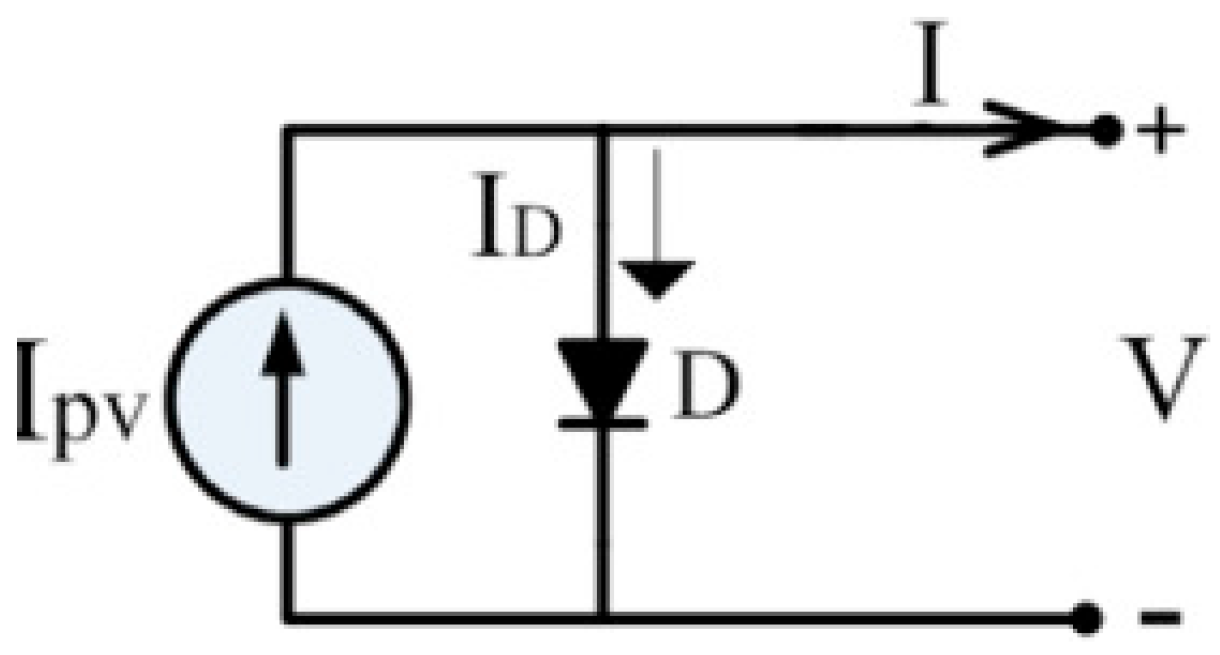

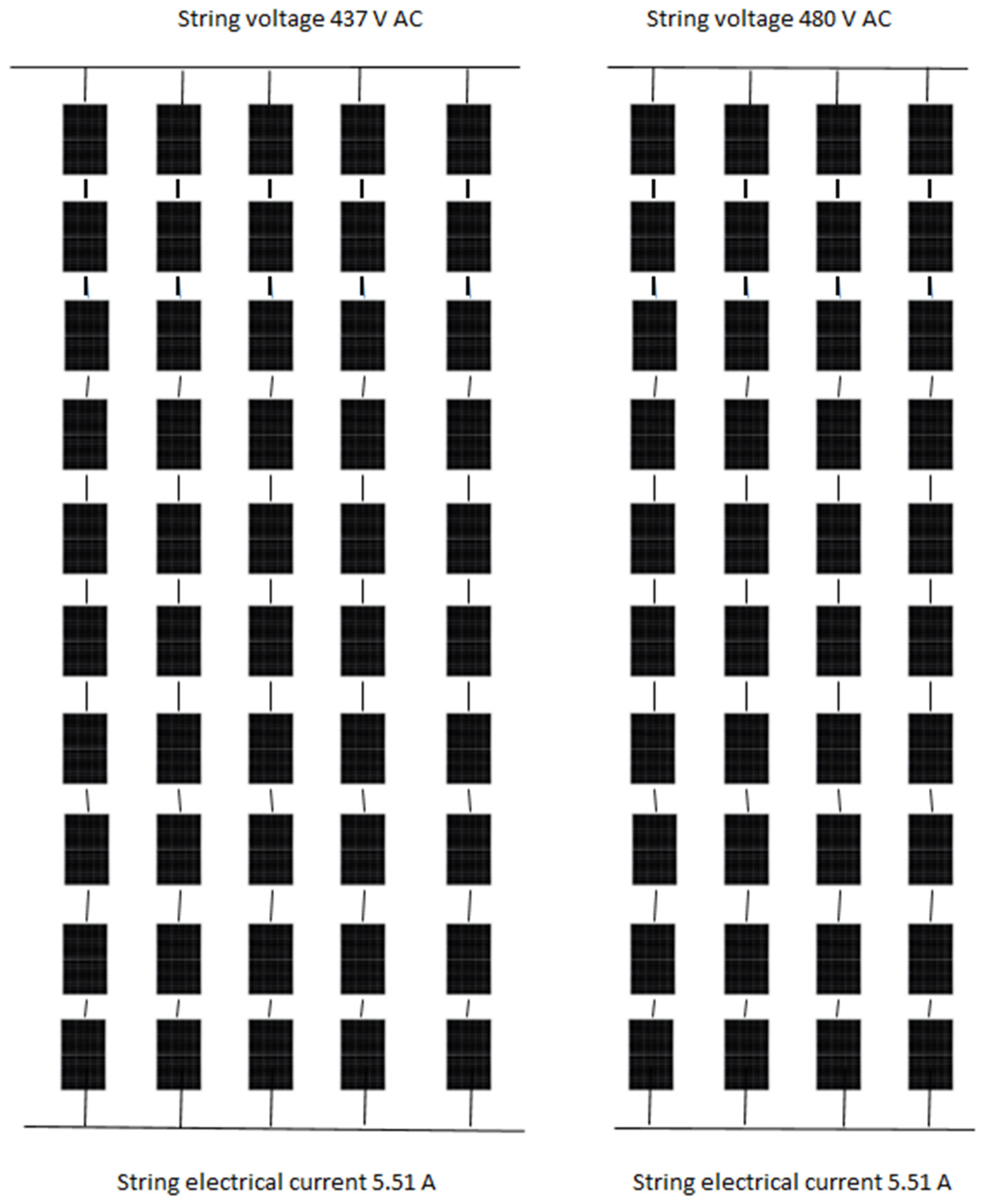
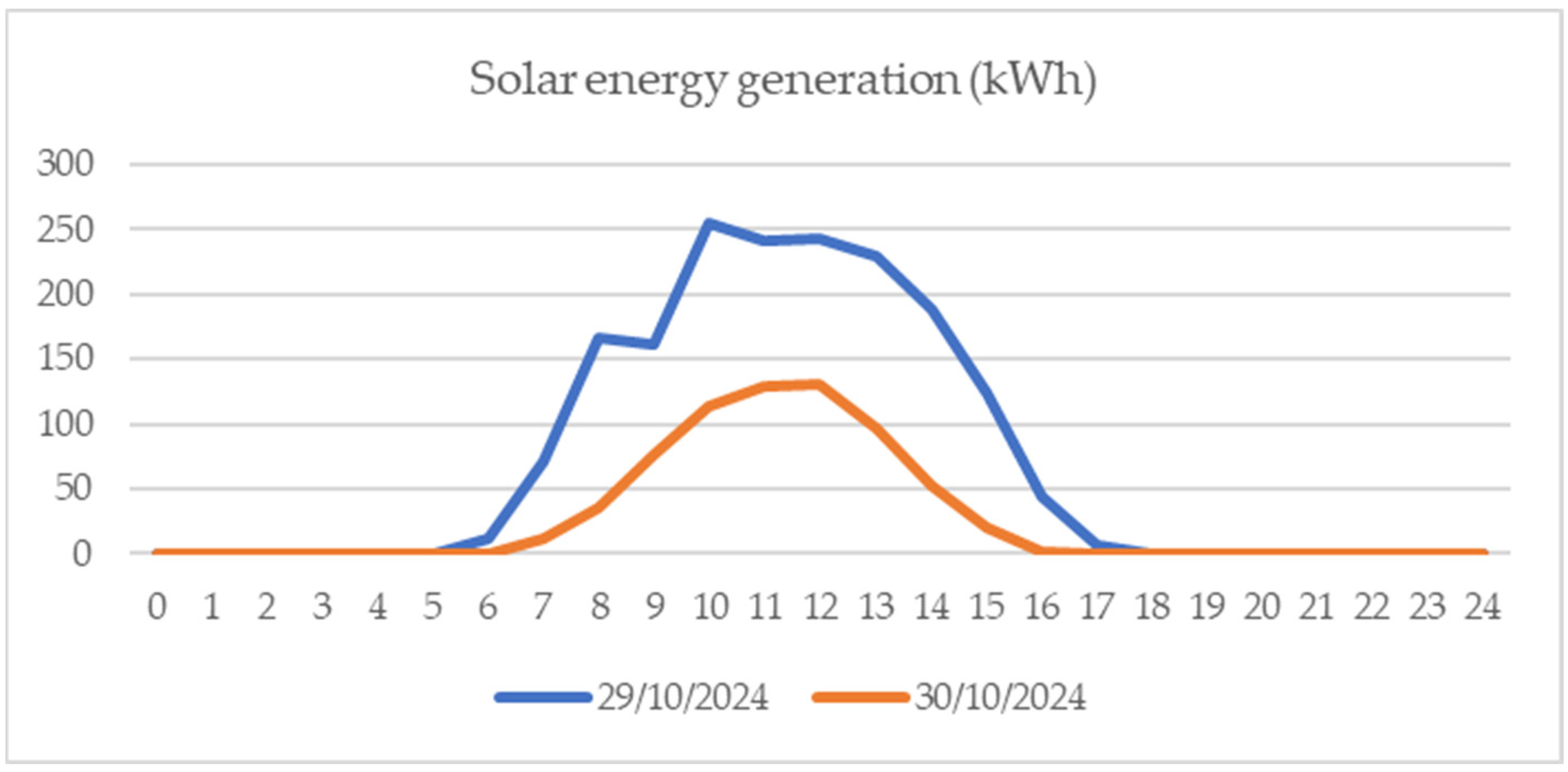

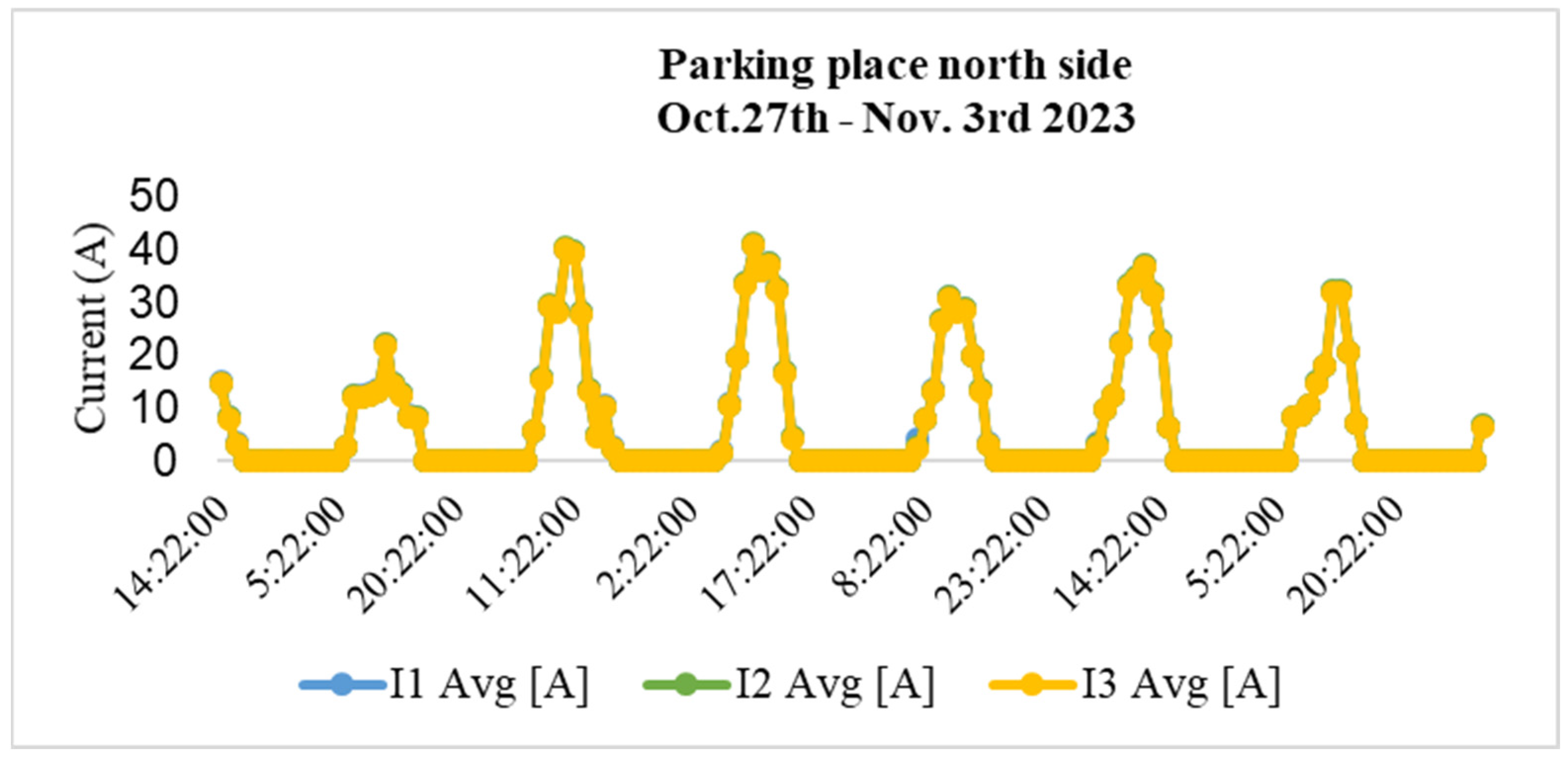

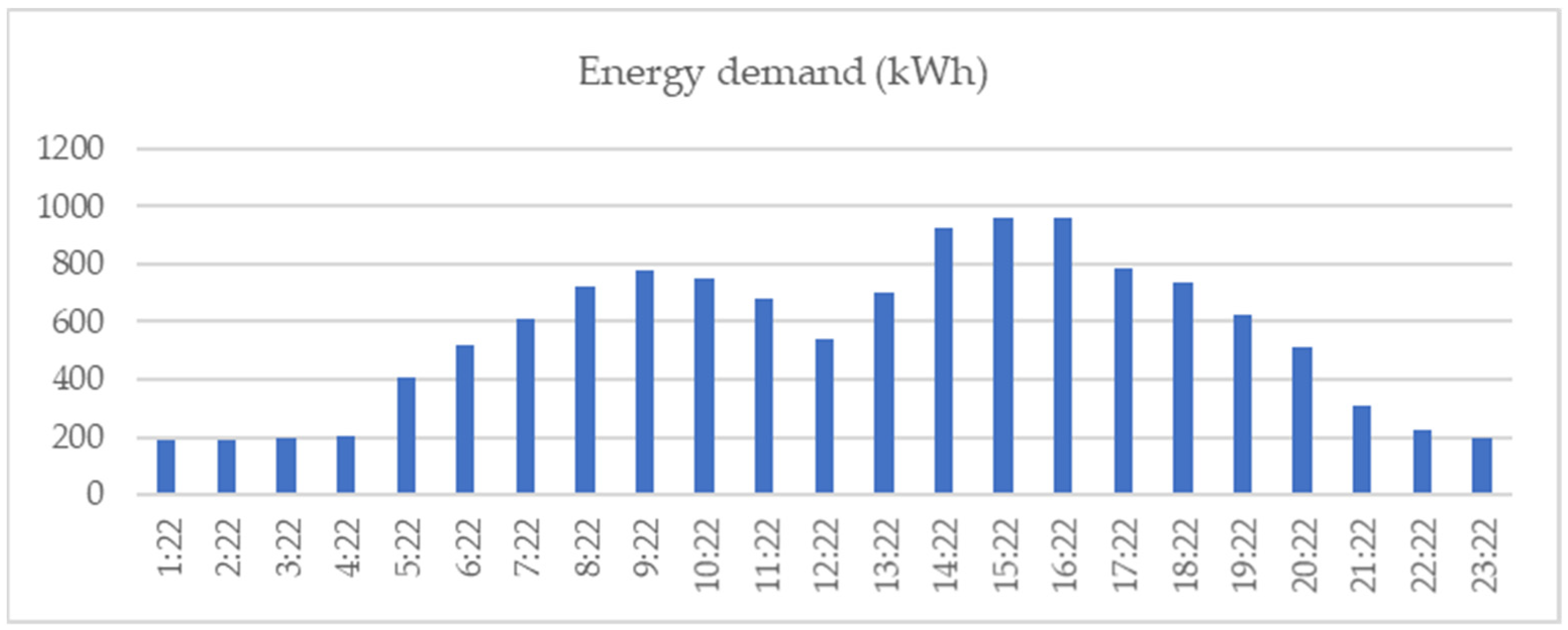

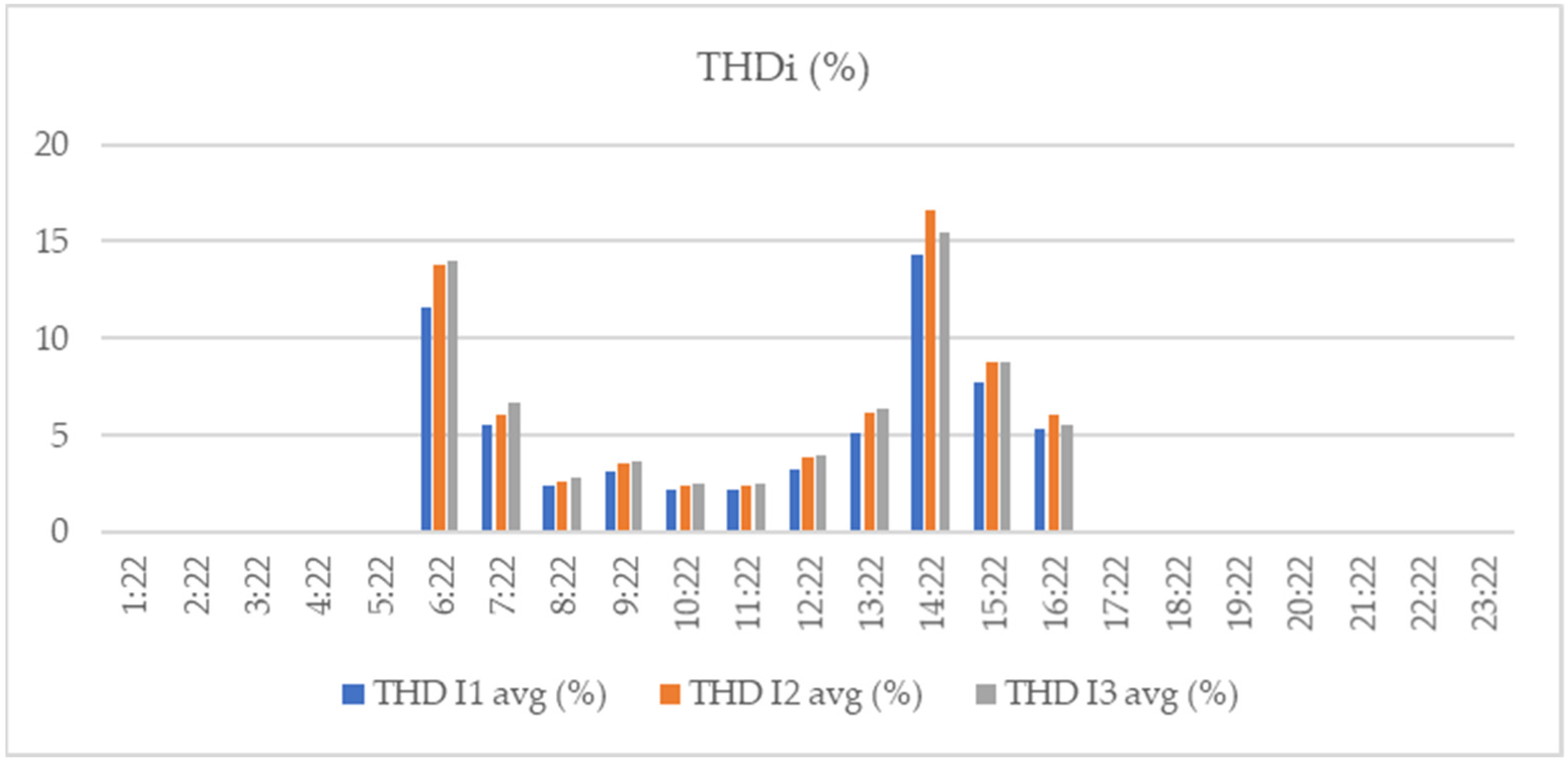
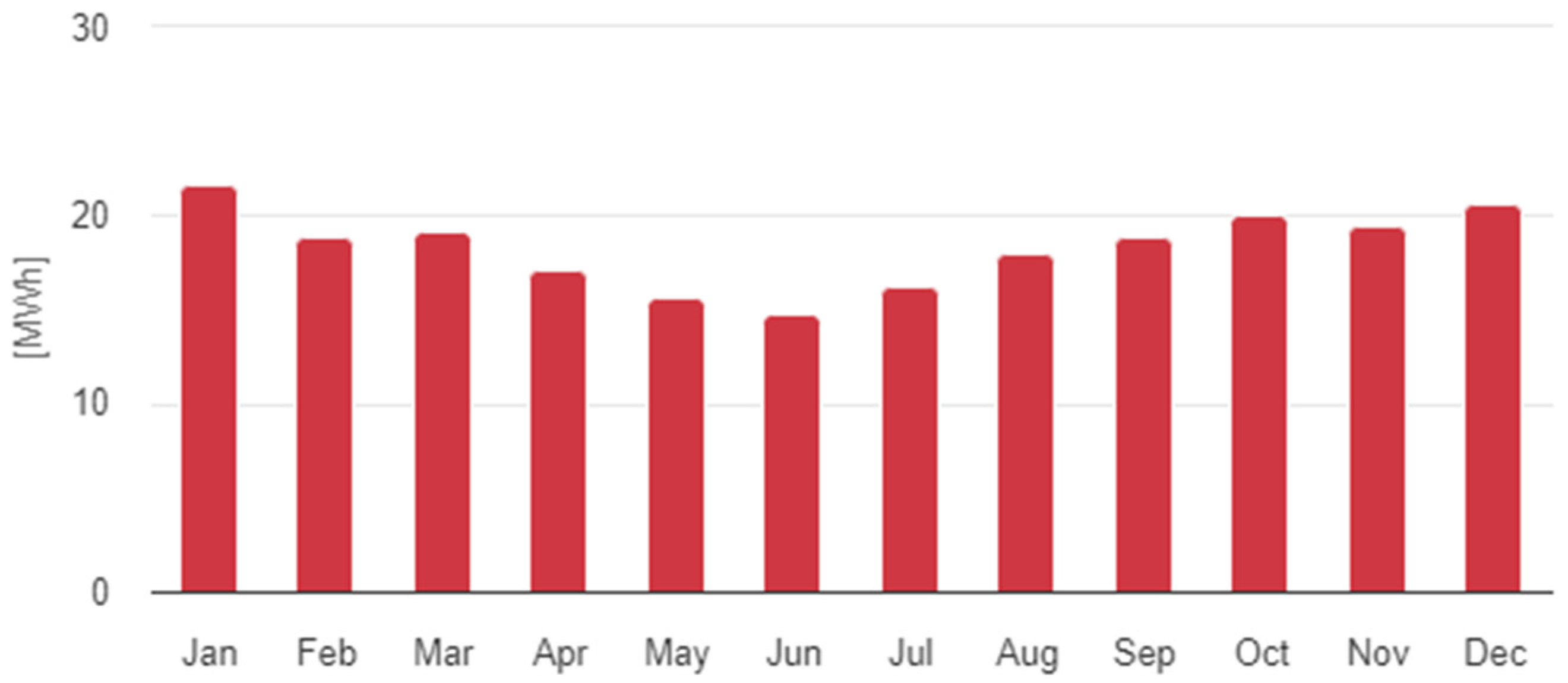
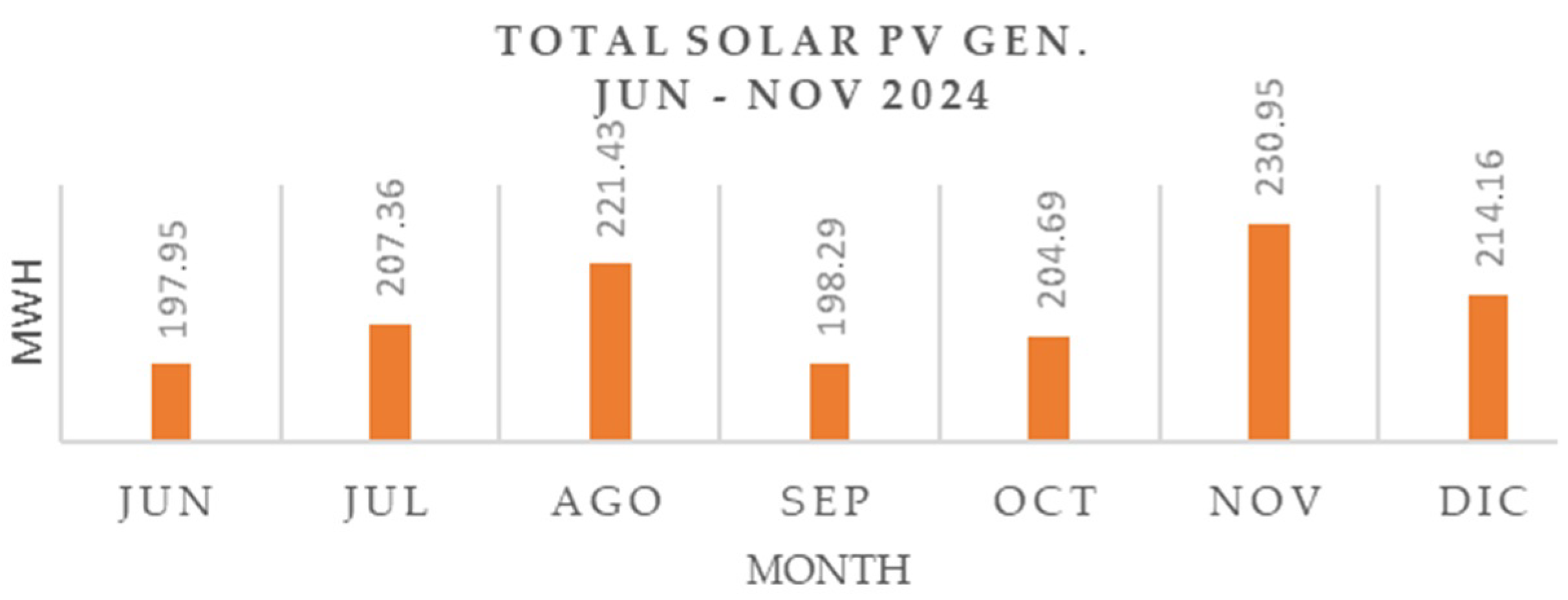




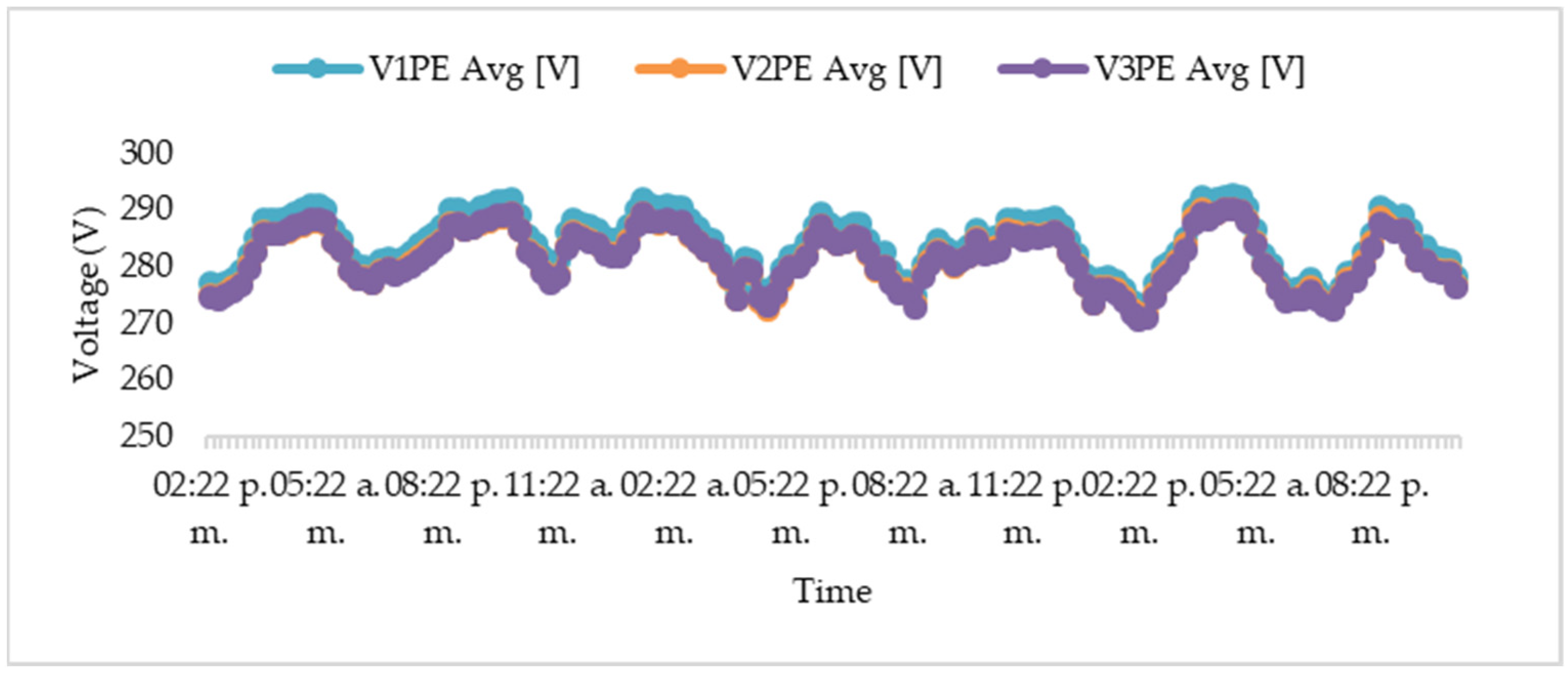
| Distortion Limits on Current for Distribution Networks | ||||||
|---|---|---|---|---|---|---|
|
Relation | TDD | |||||
| * | ||||||
| Current Distortion Limits for Subtransmission | ||||||
|---|---|---|---|---|---|---|
| * | ||||||
| Model | Panasonic 230 W |
|---|---|
| Maximum power | W (+15%/−5%) |
| Short circuit current (Isc) | 5.84 |
| Maximum power current (Imp) | 5.48 |
| Maximum power voltage (Vmp) | 43 |
| Open circuit voltage (Voc) | 51.8 |
| Technical Features | SYMO 17.5–3 480 | SYMO 24.0–3 480 |
|---|---|---|
| Max. output power | 17.495 W/VA | 23,995 W/VA |
| Output configuration | 480 V Delta + N | |
| Frequency range (adjustable) | 59.3–60.5 Hz | |
| Admissible conductor size (AC) | AWG 14–AWG 6 | |
| Display | TFT, 65,536 Colors (240 pxl) HIGH Contrast, Touch Screen |
|---|---|
| Measurements Quality | CAT IV 600 V (phase—Neutral) CAT IV 1000 V (among inputs) |
| Grid Power Quality and Flicker | EN50160 |
| Electric Energy Quality | EN61000-4-30, Class B |
| Line | Distance (km) | No. Lines | Ω/km | Ω/km | Ω/km | Ω/km | Max. (High) A |
|---|---|---|---|---|---|---|---|
| B1–BT1 | 0.006 | 1 | 0.656 | 0.187 | 1.816 | 1.369 | 125 |
| B1–BT2 | 0.35 | 1 | 0.656 | 0.187 | 1.816 | 1.369 | 125 |
| B1–BT3 | 0.09 | 1 | 0.656 | 0.187 | 1.816 | 1.369 | 125 |
| B5–B2 | 0.35 | 3 | 0.128 | 0.164 | 1.127 | 0.647 | 350 |
| B5–B3 | 0.01 | 3 | 0.128 | 0.164 | 1.127 | 0.647 | 350 |
| B5–B4 | 0.26 | 3 | 0.128 | 0.164 | 1.127 | 0.647 | 350 |
| Substation | MVA | kV | kV | GV | ||||
|---|---|---|---|---|---|---|---|---|
| S/E #1 | 0.5 | 13.2 | 0.480 | 2.3 | 2.3 | Dy5 | 21.87 | 601.4 |
| S/E #2 | 1 | 13.2 | 0.480 | 5.75 | 5.75 | Dy5 | 43.74 | 1202.8 |
| S/E #3 | 0.8 | 13.2 | 0.480 | 5.75 | 5.75 | Dy5 | 34.9 | 962.2 |
| TR-MR | 0.05 | 0.480 | 0.208 | 5.75 | 5.75 | Dyn5 | 60.1 | 138.8 |
| SAEB | kV | Cosphi r | I (A) | Emáx kWh | kW | P kW |
|---|---|---|---|---|---|---|
| E | 0.208 | 1.0 | 1.3 | 7 | 0.5 | 0.5 |
| Gen. | kV | MVA | Quantity | P kW | |
|---|---|---|---|---|---|
| PV–PAN | 0.480 | 0.048 | 1 | 1 | 48 |
| PV–PAS | 0.480 | 0.048 | 1 | 1 | 48 |
| PV–ADMON | 0.480 | 0.048 | 1 | 1 | 48 |
| PV–AC | 0.480 | 0.14 | 1 | 1 | 140 |
| PV–EB&C | 0.480 | 0.096 | 1 | 1 | 96 |
| PE | 0.480 | 1.058 | 0.85 | - | 736 |
| GB | 0.480 | 0.176 | 0.85 | - | 150 |
| Bus Name | Without PV (OFF) | +SSFV (ON) | +SSFV + BESS | ||||||
|---|---|---|---|---|---|---|---|---|---|
| V (kV) | V (°) | V (%) | V (kV) | V (°) | V (%) | V (kV) | V (°) | V (%) | |
| Bus SE#1 | 13.2 | 0.000 | 100 | 13.2 | 0.000 | 100 | 13.2 | 0.000 | 100 |
| Bus SE#2 | 13.2 | 0.003 | 99.99 | 13.2 | 0.003 | 100 | 13.2 | 0.003 | 100 |
| Bus SE#3 | 13.2 | 0.002 | 100 | 13.2 | 0.002 | 100 | 13.2 | 0.002 | 100 |
| Node #1 | 13.2 | 0.000 | 100 | 13.2 | 0.000 | 100 | 13.2 | 0.000 | 100 |
| Node #2 | 0.477 | −0.676 | 99.36 | 0.478 | −0.410 | 99.49 | 0.478 | −0.404 | 100 |
| Node #3 | 0.479 | −0.042 | 99.87 | 0.480 | −0.012 | 99.91 | 0.480 | −0.012 | 100 |
| Node #4 | 0.478 | −0.052 | 99.68 | 0.478 | −0.052 | 99.68 | 0.478 | −0.052 | 100 |
| Node #5 | 0.480 | 0.000 | 100 | 0.48 | 0.000 | 100 | 0.480 | 0.000 | 100 |
| Node #6 | - | - | - | - | - | - | 0.208 | 0.000 | 100 |
Disclaimer/Publisher’s Note: The statements, opinions and data contained in all publications are solely those of the individual author(s) and contributor(s) and not of MDPI and/or the editor(s). MDPI and/or the editor(s) disclaim responsibility for any injury to people or property resulting from any ideas, methods, instructions or products referred to in the content. |
© 2025 by the authors. Licensee MDPI, Basel, Switzerland. This article is an open access article distributed under the terms and conditions of the Creative Commons Attribution (CC BY) license (https://creativecommons.org/licenses/by/4.0/).
Share and Cite
Arteaga, J.-A.; López, Y.U.; López, J.A.; Posada, J. Decoding Harmonics: Total Harmonic Distortion in Solar Photovoltaic Systems with Integrated Battery Storage. Electricity 2025, 6, 28. https://doi.org/10.3390/electricity6020028
Arteaga J-A, López YU, López JA, Posada J. Decoding Harmonics: Total Harmonic Distortion in Solar Photovoltaic Systems with Integrated Battery Storage. Electricity. 2025; 6(2):28. https://doi.org/10.3390/electricity6020028
Chicago/Turabian StyleArteaga, Johana-Alejandra, Yuri Ulianov López, Jesús Alfonso López, and Johnny Posada. 2025. "Decoding Harmonics: Total Harmonic Distortion in Solar Photovoltaic Systems with Integrated Battery Storage" Electricity 6, no. 2: 28. https://doi.org/10.3390/electricity6020028
APA StyleArteaga, J.-A., López, Y. U., López, J. A., & Posada, J. (2025). Decoding Harmonics: Total Harmonic Distortion in Solar Photovoltaic Systems with Integrated Battery Storage. Electricity, 6(2), 28. https://doi.org/10.3390/electricity6020028







